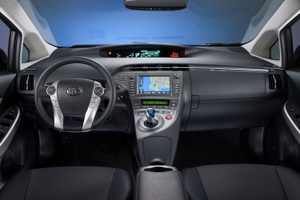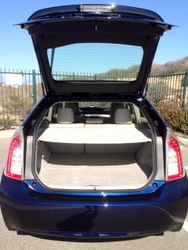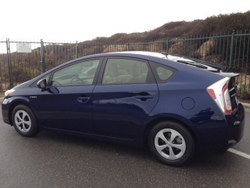The Hybrid Sales Leader Continues Its Market Dominance By Plugging In Its Icon.

In the world of automotive sales, earning the ranking of top-selling model in any category is a considerable achievement. In an internal combustion engine world, when the Toyota Prius became the best-selling vehicle line in the State of California in 2012 and then backed it up with a repeat in 2013, it was huge for a hybrid to take the prize. The Prius had a strong national presence in 2013 where it was No. 16 in sales for all cars and trucks and No. 10 among cars. To round-out the sales story, Toyota has sold 1.5 million Prius models in the last ten years, easily making it the best selling hybrid car in the United States.
The Prius four-door hatchback first went on sale in the United States in 2000 and the smaller Prius c and larger Prius V came along in 2011. They were joined by the plug-in version in 2012.
Clean Fleet Report had the opportunity to drive, in back-to-back weeks, the 2014 Prius Hatchback and the 2014 Prius Plug-in Hatchback. Here is a look at the two, where the similarities are many and the differences few.
Drivetrain
The front-wheel-drive 2014 Prius is powered by a parallel hybrid drivetrain, which Toyota calls their Hybrid Synergy Drive. In the parallel hybrid system the electric motor can power the car by itself, the gas engine can power the car by itself or they can power the car together.

Plug-in Prius gets you to new placesThe Hybrid Synergy Drive system comprises a 1.8L DOHC, four-cylinder gasoline engine with an electric motor producing a combined 178 horsepower (hp). It adds a 26 hp/60 kW nickel-metal-hydride (Ni-MH) battery and through the electronically controlled Continuously Variable Transmission (ECVT) delivers 51 city/48 highway for a combined 50 mpg.
The Prius Plug-in is powered by the same gasoline engine and electric motor but adds a 80 hp/60 kW lithium-ion (Li-ion) battery pack that can power the car solely on electricity for about 11 miles. The Prius Plug-in fuel economy is a bit different with 51 city/49 highway but the same 50 mpg combined, but the Plug-in also delivers a 95 mpge when run in EV mode. As with all plug-in hybrids, the driving style and charging regimen will determine actually mileage in the real world.
The Prius Plug-in Li-ion battery is charged by plugging in or through the regenerative charging system, which converts kinetic energy into electric energy and stores it in the battery when applying the brakes or coasting. There is a standard drive mode “D” or the “B” mode, which recharges the battery at a faster rate when coasting downhill.
In addition to the regenerative charging, the primary method to replenish the batteries is by plugging in. Here’s how much time it will take:
120V 3 hours: discharged to a full charge
240V 1.5 hours: discharged to a full charge
The Prius Plug-in does not come with a 480V Quick Charge option.
Driving Experience: On the Road
The four-door Prius Hatchback 2014 weighs in at 3,042 lbs, with the weight well distributed due to the under-seat battery placement, resulting in a low center of gravity. The electrically power-assisted rack-and-pinion steering, the front MacPherson struts with stabilizer bar and rear Torsion beam suspension delivers a smooth, although not necessarily quiet, highway ride. The Prius with the 15-inch alloy wheels (17-inch ones are an upgrade) corners so-so with little body roll, but with no sense of feeling sporty. Acceleration 0 – 60 is listed by Toyota at 10 seconds, but that may be the minimum time it takes. No head snapping going on with the Prius, but off-the-line drag racing is not why a million and a half of these have been sold. So, expecting a performance level that Toyota never promised is unfair. But let’s get real on what is fair, fuel economy!

The Prius Plug-in (which weighs in at 3,165 lbs.) offers up-to 11 miles on pure electricity if you go no faster than 30 mph. Other than that, there is little difference in the two models. Once up to freeway speeds, both Prius models shine, delivering 50+ mpg. And if you are into hypermiling, the practice of energy-efficient driving aimed at improving fuel economy beyond the EPA ratings, you may want to see how far you can squeeze that gallon of gasoline or kilowatt of electricity. You don’t need to own a hybrid or EV to practice hypermiling, but it seems this is a hot topic among Prius owners trying to out-distance each other.
Toyota has mastered combining the regeneration system with the four-wheel disc brakes with ABS. Both Prius models stop straight and true with no brake fade.
Driving Experience: Interior
The 2014 Prius has a spacious interior with a twin cockpit design with a “floating” center stack separating the bucket seats. I say “floating” because where most cars have solid sides to their center stack, on the Prius this area is an open tray. Once I got accustomed to fishing around for my stashed items, it was quite handy. The tilt/telescopic steering wheel has all the usual control buttons (audio, phone, cruise control, climate, Bluetooth, etc.) including the ability to switch between fuel and battery (hybrid) gauges. Another unique design feature is that the gauges are off to the right a few degrees. Toyota makes-up for this by having a heads-up display (standard on the Four Model–Prius Liftbacks come in Two, Three, Four and Five trim levels) that appears on the windshield directly in-front of the driver. All-in-all it’s a workable system after a short learning curve.

The Prius comfortably seats four full-size adults (five in a pinch), but the front bucket seats could use more thigh bolstering. There is plenty of storage space with or without the 60/40 rear seats folded flat. The car has good sightlines once you get over the spoiler cutting horizontally midway through the rear window. One oddity is that a beeper goes off inside the cabin when shifting into reverse. Odd because as the driver you know you put the car in reverse, the Rearview Camera pops-up on the screen and the beeping is not heard outside of the car where it would be the most useful.
The 2014 Prius is well equipped for safety with remote keyless entry, power door locks, TPMS (Tire Pressure Monitoring System), projector beam halogen headlights, seven airbags, adaptive cruise control, vehicle stability and traction control and the optional intelligent parking assist and lane departure warning.
Driving Experience: Exterior
The Prius is one of the most recognizable vehicles on the road. Its wedge-shape has not changed much since redesigned in 2004 and, either you like it or you don’t. The shape is driven completely to reduce wind resistance and drag to increase fuel economy (both Prius models have an excellent .25 coefficient of drag). Rumor has it a new Prius design is a couple of years away, but it would hard to believe that Toyota would venture very far from the general overall shape of the current car.
Pricing
The 2014 Prius base price is $25,010, including the $810 destination charge. The nicely optioned Prius Four I was driving is priced at $33,290 including the $810 destination charge. The Prius Plug-in, which starts at $29,990 including the destination charge, qualifies for Federal and State tax credits that could reduce your final cost. Clean Fleet Report recommends contacting your CPA before considering a Prius Plug-in purchase so you are completely clear on the tax credits. Not relying on the dealer to provide this information will serve them and you best.

Also worth noting is that in California the Prius Plug-in qualifies for the coveted car pool stickers allowing the driver, with no passenger, to use the HOV lane. This is no small thing when trying to get anywhere on a freeway in the Golden State, but those stickers may only be available for a few months as the demand for them has been strong.
The 2014 Prius comes with these warranties:
- 3-year/36,000 Comprehensive
- 5-year/60,000 Powertrain
- 5-year/Unlimited-mileage Corrosion
- 8-year/100,000-mile Hybrid-related Component Coverage
- 15-year/150,000-mile Hybrid-related Component Coverage (applicable states are: CA, MA, NY, NJ, VT, CT, ME, NM and RI) with the exception of the hybrid battery. The hybrid battery is warraned for 10 years/150,000 miles
Observations: 2014 Toyota Prius Hatchback and Prius Plug-in Hatchback
You will also pay additional for the Prius Plug-in, with a base price of $29,900 versus the base Prius Hybrid at $24,200. Both prices do not include the $810 Destination Charge. So as you can see, a $5,700 premium for

the plug-in will be a consideration at purchase time for what amounts to the ability to drive approximately eleven miles on pure electric charge and if you live in California, apply for the stickers that allow a single driver to use the car pool lanes. Hence, the conundrum.
Words and Photos by John Faulkner
Posted on March 23, 2014
Related Stories of Interest:
Top Ten Best Fuel Economy Cars for 2014
Toyota Is “All In” on Fuel Cell Electric Cars
GM & Toyota Go Opposite Directions in Pricing Their Plug-ins

17 thoughts on “Comparison Road Test: 2014 Toyota Prius & Prius Plug-in”